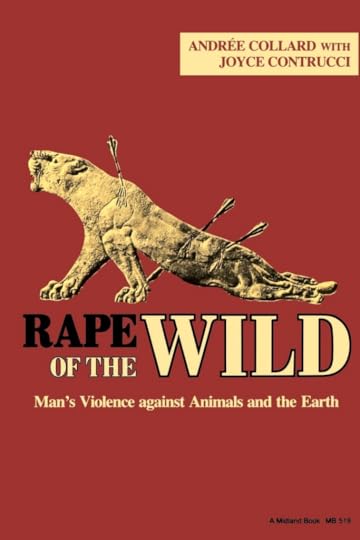Rape of the Wild excerpt, Andrée Collard, 1986
“… As we capture, confine, control, cull and kill animals, we strip them of their freedom/wildness. No longer determined by their own nature and being, wildlife has been defined in relation to man-the-predator.
What does this… do to ourselves? We prey on each other, as in crimes and wars. We give up our freedom to think for ourselves and act independently and interdependently. We are no longer wild in the sense in which all animals were once wild, that is, self-regulated and interacting dynamically with a self-regulating environment. As we manage the environment, so we control ourselves following arbitrary social and political directives. We become civilized.
It is interesting to think about what goes into becoming civilized. Looking at the word itself tells us many things, not only about what we have become but also about why there is no future for wildlife. To be civilized, we struck a bargain with the city-state, the civitas of ancient Rome that gave us the word ‘city’ and its derivatives. In exchange for self-regulation (freedom), ‘we’ received certain rights and privileges- the right to own property, to vote, to receive legal protection, and so on. We became polite, policed, and political, which is the same thing as being civilized, for these words are based on the Greek polis (city-state), whose structure the Romans imitated when they founded their civitas. We became civil citizens, that is, tamed city-dwellers. We allowed ourselves to be policed by placing ourselves in the position of children in relation to parents, that is, we became civilians belonging to the city-state… Civilization and wildness do not mix. Civilization would fall apart if it tolerated freedom (self-regulation, wildness). Wildness cannot assimilate civilization without being consumed by it.
…Wildlife has everything to lose whether it is ‘allowed’ to remain where it belongs (in the wilderness) or whether it is taken to reservations. If it remains, it will eventually lose its habitat under the demands for space of a growing human population and gradually die off. If it is taken to reservations, it will lose its wildness, its self-regulation…
This is a non-future for wildlife. If we manage to stop destroying the earth, it is likely that most land surfaces will someday look like the US and much of Europe with their concentrated production centers, densely populated cities, tentacular suburbs, and endless expanses of tarmac, covering what was once the wilderness. There will be the usual abundance of pets which will add a predatory threat to the remaining ‘wildlife’. There will be zoological ‘gardens’ and aquariums, national parks and sanctuaries where, for a fee, ‘wild’ animals can be viewed. Everything else will be pre-served in museums, in special collections of dead – and extinct – species. The image of once living, free-ranging animals will be preserved as motifs on T-shirts, cups, trays, towels, calendars, greeting cards, etc. The sonf of birds that will awaken one in the morning will be recorded and broadcast over the radio, or captured on cassettes such as the ‘Audible Audubon’ that one can take into the surrounding man-made environment. Popular television series like National Geographic Specials, and speciality shows in which organized, scientific information abounds, will be the closest approximation people will have of the natural world. Many people will miss the wilderness. Everywhere, those who do will scramble for whatever land remains, yearning to return to ‘the simple life’, in direct contact with living trees and flowers and animals but, above all, in search of self-regulation and control of the quality of their lives. Multitudes will support all kinds of conservancies in an effort to preserve their treasured ‘natural’ heritage for their children’s children.
How to determine the ground rules for the new conservation ethics necessary to accommodate the animals invaded by civilization has been under consideration for a number of years…
(pp 155-157)




